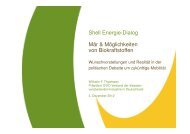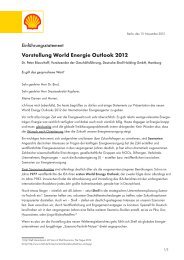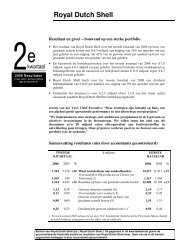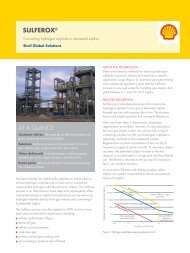Shell Bitumen - Cariphalte - Megget Resevoir Case Study
Shell Bitumen - Cariphalte - Megget Resevoir Case Study
Shell Bitumen - Cariphalte - Megget Resevoir Case Study
Create successful ePaper yourself
Turn your PDF publications into a flip-book with our unique Google optimized e-Paper software.
SHELL CARIPHALTE<br />
<strong>Bitumen</strong>ous grouting to repair and protect the reservoir<br />
supplying Scotland’s capital city with water<br />
CASE STUDY: MEGGET RESERVOIR<br />
The <strong>Megget</strong> reservoir, in the Borders region<br />
of Scotland, holds 64,000 mega litres of<br />
water to supply the city of Edinburgh and its<br />
450,000 residents. It supplies 100 million<br />
litres of water daily. In the first project of its<br />
kind in the world, bitumenous grouting was<br />
used to repair and reinforce protection for a<br />
reservoir embankment.<br />
The 56m high by 570m long dam is a gravel<br />
filled embankment with a central asphaltic core.<br />
The reservoir is retained by the largest earth dam in<br />
Scotland. The upstream face of the dam is protected<br />
against wave action erosion by graded quarry rock,<br />
known as ‘rip-rap’, on a granular filter.<br />
First project of its kind in the world - bitumenous grouting<br />
used to repair Scotland biggest earth dam reservoir<br />
Critical Success Factors: Allowed reservoir to continue operating<br />
Maintained fish stock<br />
Minimal maintenance required<br />
Low installation costs<br />
Application: <strong>Bitumen</strong>s grout<br />
Volume: 1,100 tonnes of 100 pen bitumen supplied<br />
Product family: <strong>Shell</strong> <strong>Cariphalte</strong><br />
Client: East od Scotland Water<br />
Contractor: Hesselberg Hydro<br />
Project Engineer: Whatlings (Civil Engineering) Ltd
This has suffered continuous erosion since 1983 when the<br />
reservoir was filled and a wind-wave investigation showed that<br />
waves were greater than designers had anticipated. Repairs<br />
had to be carried out on an ongoing basis, resulting in high<br />
maintenance costs and considerable disruption.<br />
<strong>Bitumen</strong>ous grouting offers the best long term solution<br />
East Scotland Water undertook a study to evaluate methods for<br />
upgrading the existing rip-rap protection layer to ensure minimal<br />
maintenance and long term service. Options assessed included<br />
the installation of an additional layer using bigger rock elements,<br />
a shallower upstream slope angle, concrete block work or<br />
bituminous grouting.<br />
The contractors, Hesselberg Hydro, undertook on-site trials and<br />
visited asphaltic coastal defence structures in Holland which<br />
suffered a similar wave attack. As a result of extensive research,<br />
they selected bituminous grouting.<br />
“The <strong>Megget</strong> reservoir supplies 100 million<br />
litres of water daily and is the first project<br />
of its kind in the world. <strong>Bitumen</strong>ous grouting<br />
was used to repair and reinforce protection<br />
for a reservoir embankment.”<br />
Bituminous grout is an homogeneous mixture of mastic, consisting<br />
of penetration grade bitumen, limestone filler and natural medium<br />
to fine sand, together with small graded crushed stone or gravel.<br />
For further information<br />
please contact your <strong>Shell</strong> <strong>Bitumen</strong><br />
representative or visit;<br />
www.shell.com/bitumen<br />
The <strong>Shell</strong> emblem, <strong>Cariphalte</strong> and SHELL are trade marks of the <strong>Shell</strong> Group.<br />
03/2011/ CS5<br />
A tailored solution<br />
The <strong>Shell</strong> <strong>Bitumen</strong> team came on board and were able to quickly<br />
add value to the project, working in close collaboration with the<br />
main contractors, Hessel Hydro, advising on the best application<br />
method and product mix.<br />
A pattern grouting technique was selected to provide maximum<br />
strength, while also limiting the amount of grout, and maintaining<br />
adequate porosity of the rock layer to dissipate the hydraulic<br />
energy of breaking waves and water pressure. It also provided<br />
the most economical long-term solution.<br />
The viscosity of the mixture was critical to ensure the grouting<br />
penetrated the full depth of the rip-rap layer, but also gave sufficient<br />
stability to the existing rock after cooling, without sagging at<br />
ambient temperatures on the steep slope of the embankment.<br />
The most economic and practical solution<br />
Full scale site trials prior to the award of the main contract<br />
demonstrated the increased strength of the rock layer while<br />
retaining adequate porosity<br />
27,000m 2 upgraded with pattern grouting on a 2.5m grid<br />
On site production of 10,500 tonnes of mastic<br />
Full using made of mobile quality control laboratory<br />
Mastic grout applied hot from specially designed skips,<br />
penetration relying on gravity<br />
Completion was on time in and within budget.


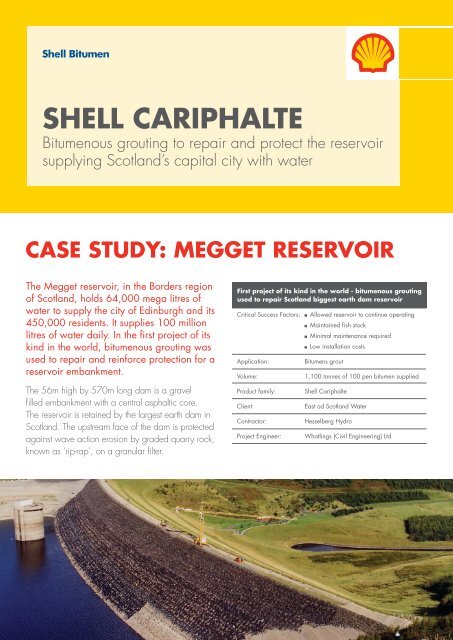

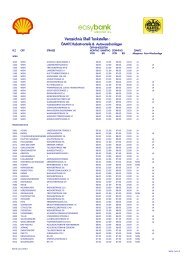
![Download Shell AutoGas Stationen [Stand: Januar 2013] (PDF](https://img.yumpu.com/9982753/1/190x245/download-shell-autogas-stationen-stand-januar-2013-pdf.jpg?quality=85)
